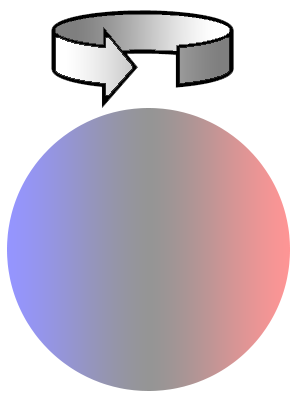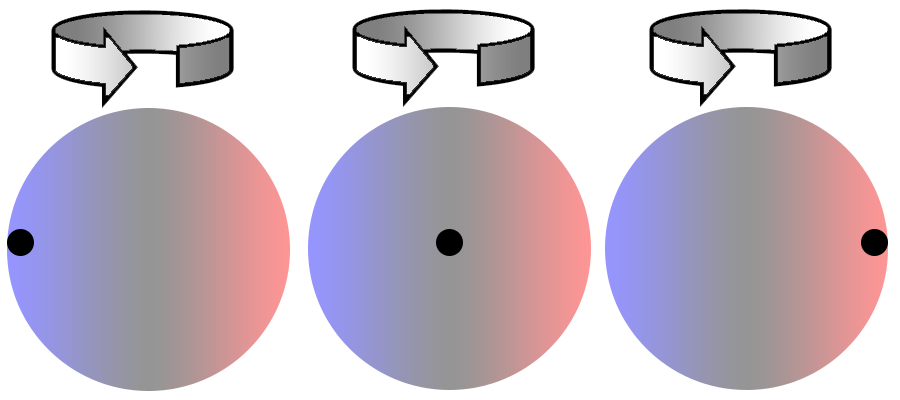We have been examining the recent discoveries of extrasolar planets – those planets that orbit a star other than the sun. Several thousand exoplanets have been discovered. In many instances, we know only the orbital period and minimum mass of the planet. In cases where the planet passes directly in front of its star, we are also able to estimate the size of the planet, its true mass, and therefore its density. But through some careful measurements and ingenious reasoning, there is additional information we can learn about exoplanets. And these new discoveries challenge the secular view of origins.
Spectroscopy
Physicists often have to devise clever ways to discover scientific information that is not easily accessible in a typical laboratory. For example, the mass of an electron cannot be measured on a balance the way we would measure the mass of a rock. Indirect methods must be used, and some of these are ingenious. In astrophysics, the challenges are even greater because we do not have direct access to distant stars. Instead, we depend upon God to set up the conditions of the “experiment,” and we must use careful reasoning to interpret the data He has already provided.
Fortunately, many things in space glow; stars and nebulae emit light. Some of the photons (the particles of light) reach earth, and they carry with them some information about their source. This is the main reason we are able to know about anything beyond our solar system. By separating and analyzing the wavelengths of the incoming light, we can learn a great deal about the source of that light. This type of analysis is called spectroscopy.
The light from a distant star is directed into an instrument called a spectroscope. This device splits the light into its constituent wavelengths (“colors”), directing them to different locations and forming a spectrum – much like a rainbow. Careful analysis will reveal thin, dark lines in this spectrum, indicating that certain wavelengths of light are missing or at least greatly suppressed. These are called absorption lines and are due to the energy levels of electrons in the atoms of the outer layers of a star. Each element has a specific set of absorption lines for a given temperature range. So, these absorption lines are like an atomic fingerprint. They tell us exactly what stars are made of, and also the surface temperature. We know this because we can produce the same kinds of lines in a laboratory on earth by heating various elements to a given temperature, and observing the resulting spectrum.
From spectroscopy, we know that all observed stars are comprised almost entirely of hydrogen and helium gas – the two lightest elements. Trace amounts of heavier elements are also present. But the spectrum of a star also reveals additional information, such as the star’s radial velocity – that component of its velocity that is directly toward or away from observers on earth. This is because of the Doppler effect.[1] If a star is moving toward earth, the wavelengths of its light are reduced, and the spectral lines are shifted toward the blue end of the spectrum – a blueshift. If a star is moving away from earth, its light is increased in wavelength, and its spectral lines are shifted toward the red end of the spectrum – a redshift.

Now consider what happens if a star is stationary relative to us, but rotating. Suppose the star’s rotation axis is perpendicular to our line of sight, with its left side rotating toward earth and its right side rotating away. Then the left side of the star will be blueshifted, and the right side redshifted, whereas the center of the star will have no shift at all. Since stars are so incredibly distant, we cannot distinguish the left side of the star from the right side; we get all the light combined. Some of that light will be redshifted, some blueshifted, and some not shifted at all. Thus, the spectral features of a rotating star will be smeared out. Broad spectral lines can indicate a rapidly rotating star.

Since the star is essentially a sphere, the blueshift from the approaching hemisphere matches the redshift from the receding hemisphere. Therefore, there will be no net shift in the absorption lines. They will simply appear broader than they would for a non-rotating star. But that situation changes when we have a transiting planet.

The Rossiter-McLaughlin Effect
Suppose a rotating star also has an orbiting planet that passes directly in front of the star once every orbit as seen from earth – a transit. Suppose the planet orbits in the same plane in which the star rotates and in the same direction. Then what would we observe on earth using a spectroscope?
When the transit begins, the planet will obscure a portion of the approaching, blueshifted limb of the star. Thus, the blueshifted light will appear slightly reduced from our perspective on earth, resulting in a slight overall redshift. As the planet moves toward the center of the star, it no longer covers the blueshifted limb, and the net shift of the star returns to normal. Near the end of the transit, the planet has moved and now obscures a small portion of the receding, redshifted limb of the star, thereby blocking a small portion of the redshifted light. So, from our perspective on earth, we will observe a slight net shift in the spectral lines toward the blue. After the transit is over, the absorption lines will return to normal. Thus, we can observe a slight change in the net position of spectral lines in a rotating star during a transit. This is called the Rossiter-McLaughlin effect.

Note the order of events. We see a slight redshift at the start of the transit, followed by a return to normal, followed by a slight blueshift near the end of the transit, and a return to normal after the transit is over. This presupposes that the planet revolves around the star in the same direction that the star rotates. This is the case for planets in our solar system. They all revolve counter-clockwise as viewed from the north, and the sun rotates counter-clockwise as well. Indeed, the secular view of the origin of the solar system (and other stellar systems) requires the planets to form in the same plane and with the same orbital direction as their star. This would have to be the case if a nebula collapsed into a solar system due to conservation of angular momentum.
So, imagine the surprise when astronomers found that some transiting events produce a Rossiter-McLaughlin effect in the wrong order! That is, the absorption lines appear slightly blueshifted (relative to normal) at the beginning of the transit, and become redshifted near the end. This indicates that the planet is orbiting the star in the opposite direction that the star rotates: a retrograde orbit.
The first such retrograde exoplanet to be discovered was WASP-17b.[2] It was also the first “super puff” (a planet with exceptionally low density) to be discovered. The planet is nearly twice the size of Jupiter but only half the mass. The planet is also a “hot Jupiter” since it orbits its star every 3.735 days at a distance of only 0.0515 AU. Since then, several other backwards-orbiting exoplanets have been discovered. These are directly contrary to the predictions of the standard secular model of origins.
Conversely, these planets are consistent with biblical creation since God has instilled diversity into His universe. Solar systems did not form from a collapsing nebula, but were spoken into existence by the Lord (Genesis 1:14-19; Psalm 33:6). He made some systems in which the planets orbit in the same direction as their star. This is the most stable configuration. But, apparently, the Lord made some planets that orbit backwards. And then it gets even weirder….
A Preponderance of Perpendicular Planets

In a recently published research paper, astronomers carefully measured the relative orientation of exoplanet orbits relative to the rotation axis of their star.[3] They limited the study to a handful of star systems for which the true orientation of the rotation axis could be estimated.[4] Amazingly, they found that a large number of these planets orbited their star in a plane that is roughly perpendicular to the rotation plane of the star.
Of the 57 analyzed star systems, 19 orbits were tilted relative to the star’s rotation plane by at least 60 degrees. Of these, 9 orbits were within only 10 degrees of being perpendicular to their star’s rotation plane, and 13 were within 20 degrees. It seems as if many exoplanets prefer to orbit their star sideways. Eleven orbits were tilted more than 90 degrees, which technically makes them retrograde planets. These interesting star systems certainly exhibit the Lord’s creativity. But they should make every secular astronomer rethink his or her position on origins because these just don’t fit with the nebular collapse model. There is no known natural phenomenon that would produce these sideways and backwards orbits in such abundance.
Even in our own solar system, the data do not quite fit the secular narrative. Although all the planets orbit in the same direction as the sun, the orbital plane of the planets is tilted by about 7 degrees relative to the rotation plane of the sun. How could that be the case if they all formed from one spinning, collapsing nebula? Conservation of angular momentum prevents a spinning object from changing its rotation axis unless acted upon by an outside torque. Thus, if the solar system formed from a spinning nebula, either the orbital plane of the planets or the rotation axis of sun was somehow altered by seven degrees by some outside influence. But the energy and momentum transfer for such a feat is outrageous. So just imagine how much more absurd it is (from a secular perspective) that so many exoplanets orbit in a plane that is tilted about 90 degrees relative to the rotation plane of their star!
The secular story just doesn’t fit the data. That has always been the case and secular scientists have become adept at inventing rescuing devices to explain away the data. For example, hot Jupiters were not supposed to exist in the secular narrative because strong stellar winds from a young star should have blown away the hydrogen envelope of any planet orbiting so close. So, secular astronomers have supposed that these planets formed far away from the star, and then migrated in somehow. And planets should orbit in the same plane as the rotation of their host star if they formed from the same nebula. Some planets do this, but many don’t. Some orbit perpendicular or even backwards! What explanation will the secularists come up with this time? Will secularists ever abandon their origins stories and focus on science?
[1] This is simplified for clarity. The redshifts and blueshifts of stars also include a component of time dilation. The full, relativistic Doppler shift formula is derived in the book The Physics of Einstein.
[2] Anderson, et al., WASP-17b: An Ultra-Low Density Planet in a Probably Retrograde Orbit, 2010, The Astrophysical Journal 709, p. 159-167
[3] Albrecht, S., et al, A Preponderance of Perpendicular Planets, 2021, The Astrophysical Journal Letters 916 L1.
[4] For the majority of exoplanets, only a sky-projected angle can be deduced. This is enough information to determine if the planet has a retrograde orbit, but the true 3D orientation of the system is not known.

